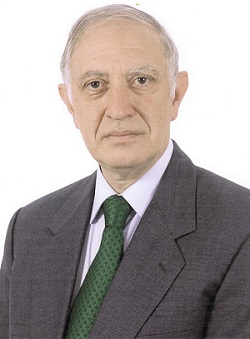Intellectual Trajectories Talk: Francesco Iachello
 Francesco Iachello is the J.W. Gibbs Professor Emeritus of Physics and Professor of Chemistry at Yale University.
Francesco Iachello is the J.W. Gibbs Professor Emeritus of Physics and Professor of Chemistry at Yale University.
Professor Iachello’s work has been dedicated to the study of symmetries in physics through the introduction of models based on symmetry and their application to physical systems.
In 1974, Professor Iachello introduced the interacting boson model of the nucleus. This model, developed in 1975–79 with Professor Akito Arima of the University of Tokyo, Japan, and based on the concept of dynamical symmetry, has brought order in the classification of complex nuclei and in the understanding of their properties. Together with Arima, Igal Talmi of the Weizmann Institute of Science in Rehovot, Israel, and Takaharu Otsuka of the University of Tokyo, Japan, he provided in 1977–78 a microscopic interpretation of the interacting boson model. The constituents of atomic nuclei, protons and neutrons, pair up to form proton pairs and neutron pairs. These correlated pairs have integer angular momentum, behave like bosons, and move together in a collective fashion.
In 1980, Professor Iachello introduced an additional ordering idea in the classification of spectra of nuclei, called dynamical supersymmetry. In some nuclei there are unpaired particles. These unpaired particles have half-integer values of the angular momentum, behave like fermions, and move in a coordinate fashion with the bosons. Dynamical supersymmetries in nuclei are based on the interacting boson-fermion model of the nucleus, introduced by him in 1978 and developed with Olaf Scholten of the University of Groningen, The Netherlands, in 1979–1981. Dynamical supersymmetries, developed with A. Baha Balantekin, Itzak Bars, and Roelof Bijker in 1981–83, brought order in the classification of nuclei with unpaired particles.
In 1981, Professor Iachello introduced the vibron model of molecules. This model, developed with Professor Raphael Levine of the Hebrew University, Jerusalem, in 1982–83, and also based on the concept of dynamical symmetry, provided a framework for the classification of molecules. Spectra of molecules are constructed with quanta of excitation called vibrons. In 1991–96, the vibron model was extended to the study of polyatomic molecules in collaboration with Stefano Oss of the University of Trento, Italy.
In addition to these three major achievements, Professor Iachello has explored further the concept of symmetry in the study of collisions between particles in the years 1983–86 (algebraic scattering theory) with Y. Alhassid and F. Gürsey, in the study of electronic spectra of molecules (electron-vibron model) in 1986–87 with A. Frank and R. Lemus, and in the study of spectra of hadrons (algebraic model of baryon and mesons) in 1994–96 with R. Bijker and A. Leviatan.
In 2000–01, Professor Iachello returned to the study of symmetries in nuclei and introduced the concept of dynamical symmetries at the critical point of phase transitions. These symmetries describe systems undergoing phase transitions and extend the concept of dynamical symmetry to the most challenging situation one may encounter in quantal systems.
For his work in symmetries in physics, Professor Iachello received the 1990 Eugene Wigner medal of the Group Theory and Fundamental Physics Foundation; for the interacting boson model, the 1993 Tom Bonner prize of the American Physical Society (shared with A. Arima), and for his work on symmetries and supersymmetries, the 2002 Lise Meitner medal of the European Physical Society (shared with J. Philip Elliott).
Besides these prizes, Professor Iachello has received the AKZO prize of the Netherlands Society of Sciences (1981), the Taormina Prize of Arts and Sciences (1991), the Centennial Prize of the Italian Physical Society (1997), the Italian National Medal of Science (2007), the Majorana Prize (2007), the Commemorative Medal of Charles University, Prague (2008), the Somani Volta Prize (2009), and the Enrico Fermi Prize of the Italian Physical Society (2010). He has been awarded honorary doctoral degrees from many institutions including the University of Ferrara, Italy, the University of Sevilla, Spain, Chung Yuan University, Republic of China, the University of Bucharest, Romania, the Hebrew University, Jerusalem, Israel, the Technical University, Darmstadt, Germany, and the University of Catania, Italy. He has been awarded honorary professorships from the University of Nanjing, China, and the University of Groningen, The Netherlands. He is Foreign Member of the Royal Netherlands Academy of Arts and Sciences, the Croatian Academy of Arts and Sciences, the Mexican Academy of Science, the Academia Galileana, the Academia Europaea, and the Accademia Zelantea. He is a fellow of the American Physical Society, of the American Association for the Advancement of Science, and honorary fellow of the Roland Eötvös Physical Society of Hungary and of the Hellenic Nuclear Physics Society.
For his work on symmetries in molecules, he was awarded in 1988 a professorship from the Chemistry Department at Yale University, and he is currently J.W. Gibbs Professor Emeritus of Physics and Professor of Chemistry.
Professor Iachello has served on many advisory committees including those of the Department of Energy, of the National Laboratories at Oak Ridge (ORNL), Brookhaven (BNL) and Argonne (ANL), and of the Istituto Nazionale di Fisica Nucleare, Italy, and the Grand Accelerateur National d’Ions Lourdes, France.
Professor Iachello has also written several articles on symmetries in the arts and their connection with symmetries in the sciences. Although he is a theoretical physicist, his interests extend to many other subjects, including music, especially Renaissance and Baroque music, and literature, especially Italian, Spanish, and Russian poetry of the twentieth century.